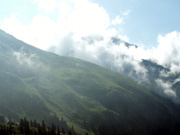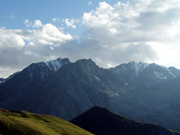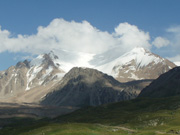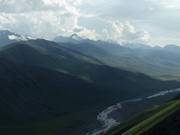One million steps for the three of us
Chapter 1. PROKHODNOYS AND OZERNIYS
Chapter 2. THE GREAT WATER
Chapter 3. SNOW AND SUN
Chapter 1. PROKHODNOYS AND OZERNIYS
Having bought all the supplies and equipment in Almaty, our group moved out according to already familiar itinerary, on Sunday morning, in direction of the resort Alma-Arasan, where last year we started our trip to the Zailiyskiy Alatau from. Half an hour in the bus, which was spent talking with inhabitants, who appreciated the weight our backpacks at their true value, kept asking us about our undertaking, and we were on the spot.
 |
Mist over the valley |
The first day obviously didn’t make us happy with the weather. Hardly an hour had passed from the moment we stepped on the path when it started pouring. Involuntary was recalled the memory about last year’s trip, when rain and dampness made us to descend two days earlier than we’d planned. But unlike last year, that time we had ample reserves of gas so we were not threatened to die because of cold and hunger.
From the gorge Alma-Arasan we were climbing up along the valley of the river Prokhodnaya, after which was the gorge named. It didn’t seem that the rain was going to stop, but our raincoats looked half of what they had looked just half an hour ago – the thinnest polyethylene kept breaking everywhere caused by any movement. Soon it had become colder and we decided to stop and have a cup of tea.
Hidden under the trees we kindled the gas-jet and very soon nice warm of hot drink petted our guts. We had hardly got warm when we were passed by the group of briskly walking tourists, and some of them were wearing bathing suits. ’It is evidently yogis’ – we thought, - as far as the weather was not suitable for sunbathing at all. But in an hour we met them again getting changed into more appropriate clothes for mountains and wood. Well, they were not yogis…
Climbing higher and higher we passed the place on the opposite side where we laid out the tents last year. Now our itinerary is considerably longer. Searching for the Aleshka’s bridge Zhenya and I had gone way forward and at last found that legendary for that locality crossing. Sasha and the girls stayed to wait for us down-stream. That was useless to cry because the river was cutting off all the sounds. So what we had to do just to wait till they understand that we were not coming because we had found the crossing and decide to catch up with us. And indeed, soon they had already been with us.
Now it was necessary to go up to the Space station to the pass Zhosalykezen. For me, personally the ascent was difficult and I managed to do it only at the cost of supreme efforts. And by the end I was just dragging behind, counting ‘portions’ of ten-twenty steps and then rested between them. Somewhere in the middle of ascent the height pasted over 3000 meters point.
 |
Zhosalykezen Pass ascent |
The itinerary we’d chosen for the first day was rather long and difficult itself and in addition the weather meddled in. Though of course, spectacle of mist and clouds in the mountains is charming (especially on comparatively low altitudes), but it only from the plain seems that the clouds slowly float across the sky. Only being on height you understand as swiftly and quick they move. There is something terrifying as you watch a cloud rushes to you and understand that you will be inside it for some time. That day the clouds passed us with interesting periodicity of 40 minutes, like submitted to the unknown for us timetable. Right after this ascent when we’d been inside the clouds one thought occurred to me that we could proudly declare: ‘We had been there where the sky met the ground’.
By the skin of our teeth climbed on the top we found ourselves at the Space station. There was a thought to stay for a night right there, because to walk somewhere else wasn’t the brightest perspective. But having thought about it thoroughly we swept aside this possibility. At this height and moreover next to the pass that would be terribly cold at night there. So after a short break the way down had begun.
Surely we were affected with both either the huge gain of the height during one day (by bus and on foot was about 2800 meters as a total) or just physical tiredness for want of habit. And for Lena it was the first mountain trip. So from the Space station down the serpentine road and till the institute named after Stenberg we were walking in complete darkness and in condition which was very close to zombies. And only Zhenya decided to go down ahead of everybody and not along the serpentine road but straight. That day all of us were surprised with his playfulness. As we found out later, descending almost in complete darkness he stumbled and rolled downhill. But that didn’t prevent him to be the first in the village and to give signals with a lamp showing the direction to us, who was walking in the dark.
 |
Sovetov Peak – the third from the left |
With a help of Zhenya’s efforts the house at very moderate price 50 tenge per a person (as we were told later that was the fee per electricity) was waiting for us. We stayed in this house for a night. It was decided in the evening that Lena had to go back and Marina would accompany her. Till late at night we were trying to dry our boots, which got soaking wet during the day. But then we gave up this hopeless work and went to bed somewhere about three o’clock in the morning. The next day began with the descent down to Big Almaty lake. The color of the lake was amazingly beautiful, but generally it was very natural for the glacial lakes. It was whitish-turquoise. Having drunk tea for the last time on the lake side we parted with Marina and Lena, who left for Almaty. And we started to drag ourselves along the river Ozernaya in direction of the pass with the same name.
On our way there we met a big group of the tourists from Ekibastuz, who were coming back from the Tourists’ pass. According to their words, the pass Aksu (one of the possible ways to Issyk-Kul ) was blocked with the snow.
Marmots in the Northern Tien-Shan are probably the most widely spread living creatures. Their whistling kept making us turning around – it really sounded like human’s one. And also they trampled down very good paths, which actually had one disadvantage – if you were inattentive you could easily get into one of their burrows and break something. Taking into consideration that little amount of provision we had with us, very soon we started to dream to slaughter a marmot with the rocks and to try fresh meat. That was very illusory dream indeed, bearing in mind their swiftness and attentiveness.
By the way, speaking about fauna. At that height and in that season a traveler is usually bothered with two disasters in turn: either it rains and you walk soaking wet and cold or rain stops and like obeying to the looked out sun the swarms of the horse-flies appear. And they try to sting you and succeed in it even through the jeans and thick shirts. First appearances of rain certainly sweep them away and you even can’t decide what bothers you more. Thinking what is better we have come up to the place where our way was blocked with the river.
 |
Half an hour before crossing over the Ozernaya River |
Ozernaya was the first river, which we had to force a crossing over. And to tell you the truth, we couldn’t make up our mind to do it for a long time, remembering one simple rule: to cross the mountain rivers only in the morning. But the perspective to dry early in the morning tomorrow and waste time on it was seducible to no one of us. That was better to cross the river today and to lay out the tents where that was possible to make the belongings dry and to receive something hot as a treatment for super cooling. Our hesitation finally disappeared after a man carrying a bicycle on his shoulders crossed the river before our eyes.
In brief, we took off our boots and ran on the ice-cold water and slippery stones. And then a series of incidents happened. Sasha owing to my and Zhenya’s effort and assistance crashed into the icy water. And Zhenya had to run across the river twice as he had left his look-see at the opposite bank. Later on it became a true tradition. In two days, for example, Zhenya left his axe on the bank in the same way.
We settled on a small hill not far from the bank for getting dry and spending the night. Mountains with slopes partly covered with snow rose to the south as a solid wall. When looking through the photos shot that evening at home I couldn’t choose the sunsets for printing. Each of mountain sunsets is beautiful and unique in its own way. The moments when the sun has disappeared but its light is still reflected like a red glow on the mountains situated to the east stick to one’s memory forever.
Not far away from us we saw a moraine for the first time (that time we didn’t know that was exactly a moraine) and it had such even edges that it seemed something made by human hands. We even called that place a ‘bunker’ as a joke.
And in the evening we had a rich and hearty meal. The cognac (there was much less left) was postponed for a while and vodka which was the warm healing remedy was taken out of the backpack. The toast of that evening was: ‘Well guys, now we know what a real forcingis but it has no relation to the movie’.
The next morning we started out towards the Ozerniy pass. Theoretically there exists a highway in this direction but in fact only a cross-country vehicle or a quadrocycle could ride through it. A group of people riding such quadrocycles rushed by when we were at an hour’s distance from the pass. At the same time we met two men from Bishkek moving from Almaty who were going to pass the route by the express method as they had only three free days.
And we saw the Ozerniy pass at last (3520 metres). The fact that we were already in Kyrghyzstan could be determined only by the GPS coordinates and the map. We didn’t see any boundary posts, men with guns and dogs or any other cordon attributes. We even had a feeling that Asia had a chance to eliminate all the boundaries some day just the way Europe is trying to do it now. It is necessary to mention that the hope was awfully ruined when we were getting back to Almaty by bus and had to pass the customs control twice (we were lucky to have registered in Cholpon-Ata, otherwise we would have troubles).
Not far away from the frontier we decided to halt and make some kidney beans with tinned stew meat. Who could know what our meal would turn out to be. The point is that we didn’t have an idea to soak the beans in the evening and did it only in the morning. The time before the dinner was evidently not enough for the beans because at the moment we put into the pot it was absolutely hard. We tediously boiled it for a long time and then decided that hot things can’t be raw and tried to eat it. It was really disgusting as the beans were hard and tasteless. But anyway we had to move forward because according to our plan we were supposed to get to the Chon-Kemin river by evening.
 |
Valley of the
Chon-Kemin river |
In a couple of hours a vast valley of the Chon-Kemin river with cloudy sky above was stretched in front of us. At the other side of the valley rose the Kungey-Alatoo mountain ridge, the second main ridge of the Northern Tien-Shan. But half an hour later we didn’t care about the beautiful views at all.
Our stomachs tried to digest the kidney beans, failed to do that and went out of order altogether. It was revealed in different ways. However, the typical thing was that the beans managed to find the way back outwards doing it repeatedly and grievously preventing us from sleeping, eating and drinking all the evening long. At night when the beans had been finally moved out of the stomachs along with all the things that had been there we fell asleep being exhausted. And that was the end of the Tuesday – the third day of our journey.
|



